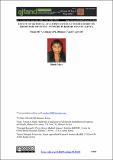Effect of maternal aflatoxin exposure through diet on growth of infants 0 - 3 months in Kisumu County, Kenya.

View/
Publication Date
2021Author
M. I., Obade, P., Andang'o, C., Obonyo, Lusweti, F.
Metadata
Show full item recordAbstract/
Aflatoxins are naturally occurring carcinogenic toxins associated with poor growth outcomes in young children. Although evidence supports mother-to-infant exposure during pregnancy and breastfeeding, evidence of its effect on growth is limited to the period after introduction of complementary foods. It is, therefore, unclear whether early maternal exposure to aflatoxins affects infant growth right from birth. Prevalence of aflatoxin levels of 40% has been observed in Nyanza region, Kenya, and 22.7% of children under 5 years are stunted. The purpose of this study was to determine the effect of maternal aflatoxin exposure on growth of infants 0-3 months old in Kisumu County, Kenya. Specific objectives were to: establish association between maternal baseline characteristics and aflatoxin exposure; establish association between infant baseline characteristics at birth and maternal aflatoxin exposure; determine effect of maternal aflatoxin exposure on infant growth indicators at 3 months of age. Out of 553 pregnant women who were screened for aflatoxin exposure, 137 exposed and 137 nonexposed women, matched for age and household income, participated in an 8-month cohort study. The women were followed up to delivery and their infants up to 3 months after delivery. Infant length and weight data was collected monthly. Length-for-age (LAZ), weight-for-length (WLZ)) and weight-for-age (WAZ) z-scores were generated. Aflatoxin levels were analyzed using Enzyme Linked Immunosorbent Assay (ELISA) in parts per billion (ppb). Effects of aflatoxin on infant growth outcomes were assessed using multi-variate linear and logistic regression. Effect of maternal aflatoxin exposure on infant length, weight, LAZ, WLZ, WAZ was determined using Cox regression with constant time at risk. Infants of exposed women had lower weight (95% CI:-0.85,- 0.53), length (95% CI: -4.08, -3.36), LAZ (95% CI: -1.93, -1.16) and WAZ (95% CI:- 1.03, -0.54) at 3 months of age, but there was no difference in WLZ (95% CI:-0.03, 0.74). Risk for stunting was higher in infants of exposed women (RR=4.08; 95% CI: 1.35, 12.29). There was no difference in the risk for underweight (RR=6.61; 95% CI: 0.80-54.33) and wasting (RR=0.37; 95% CI: 0.40, 3.39, P=0.38). These results underpin the need to reduce aflatoxin exposure in infants and young children who are very vulnerable.
